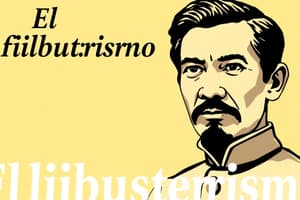Podcast
Questions and Answers
Where did Rizal complete the manuscript of El Filibusterismo?
Where did Rizal complete the manuscript of El Filibusterismo?
- London, England
- Ghent, Belgium
- Madrid, Spain
- Biarritz, France (correct)
What significant challenge did Rizal face in publishing El Filibusterismo?
What significant challenge did Rizal face in publishing El Filibusterismo?
- Negative reception from the Filipino community
- Lack of interested publishers
- Censorship by the Spanish authorities
- Lack of funds (correct)
To whom did Rizal dedicate El Filibusterismo?
To whom did Rizal dedicate El Filibusterismo?
- The Filipino people
- His friends and supporters
- The three martyr priests, Mariano Gómez, Jose Burgos, and Jacinto Zamora (correct)
- His parents
What is the main theme of El Filibusterismo?
What is the main theme of El Filibusterismo?
How does the character of Simoun in El Filibusterismo differ from Crisostomo Ibarra in Noli Me Tangere?
How does the character of Simoun in El Filibusterismo differ from Crisostomo Ibarra in Noli Me Tangere?
What was the primary purpose of Rizal writing El Filibusterismo?
What was the primary purpose of Rizal writing El Filibusterismo?
What significant change in tone does El Filibusterismo have compared to Noli Me Tangere?
What significant change in tone does El Filibusterismo have compared to Noli Me Tangere?
Who does the character Simoun represent in El Filibusterismo?
Who does the character Simoun represent in El Filibusterismo?
What personal experience inspired Rizal’s writing in El Filibusterismo?
What personal experience inspired Rizal’s writing in El Filibusterismo?
Which event directly affected Rizal's decision to travel back to Europe in 1888?
Which event directly affected Rizal's decision to travel back to Europe in 1888?
What was one reason Rizal felt bitter while writing El Filibusterismo?
What was one reason Rizal felt bitter while writing El Filibusterismo?
In what way did Rizal's personal life influence the character of Simoun?
In what way did Rizal's personal life influence the character of Simoun?
What type of government issues did Rizal expose in El Filibusterismo?
What type of government issues did Rizal expose in El Filibusterismo?
Flashcards
El Filibusterismo
El Filibusterismo
The second novel by Dr. Jose Rizal, continuing Noli Me Tangere.
Rizal's inspiration
Rizal's inspiration
Personal experiences of family persecution and land issues fueled the writing of the novel.
Simoun's character
Simoun's character
Represents the potential for radical change; suggests action alongside education.
Tone of the novel
Tone of the novel
Signup and view all the flashcards
Rizal's departure
Rizal's departure
Signup and view all the flashcards
Writing as a weapon
Writing as a weapon
Signup and view all the flashcards
Personal bitterness
Personal bitterness
Signup and view all the flashcards
Awakening awareness
Awakening awareness
Signup and view all the flashcards
Gomburza
Gomburza
Signup and view all the flashcards
Rizal's challenges in publishing
Rizal's challenges in publishing
Signup and view all the flashcards
Crisostomo Ibarra and Simoun
Crisostomo Ibarra and Simoun
Signup and view all the flashcards
Impact of Gomburza on Rizal
Impact of Gomburza on Rizal
Signup and view all the flashcards
Study Notes
The Historical Backdrop of El Filibusterismo
- El Filibusterismo is the second novel by Dr. Jose Rizal, a continuation of Noli Me Tangere.
- Rizal started writing El Filibusterismo in October 1887 in Calamba, Laguna, after returning from Europe.
- Rizal's return faced challenges; negative reactions to Noli Me Tangere led to cases against his family. Land disputes involving Rizal's family and Calamba farmers reached the Spanish Supreme Court.
- Rizal wrote El Filibusterismo to expose and raise awareness among Filipinos about Spanish oppression, corruption, cruelty, and abuses by government officials.
- Personal experiences, including family persecution, land grabbing from Calamba farmers, and unjust treatment of Filipinos, fueled Rizal's inspiration for the novel.
- El Filibusterismo displays more intense anger than Noli Me Tangere, reflecting the evils Rizal witnessed and experienced.
- Writing was a powerful tool for Rizal to fight against injustice, discrimination, and exploitation.
- Rizal employed a stronger, more explicit tone in El Filibusterismo to convey the anger and resentment of the oppressed, compared to the gentler approach of Noli Me Tangere.
- The character Simoun represents the possibility of radical change, suggesting transformation could occur through both education and action.
- The novel personally reflects Rizal's experiences; Simoun's loneliness mirrors Rizal's disappointment with Leonor Rivera, his fiancée who married another.
- Rizal expressed disappointment over the lack of support from countrymen who initially promised help but later abandoned him.
- These experiences infused a personal bitterness into Rizal's writing, leading to a novel filled with intense emotions and anger.
- Forced to leave the Philippines due to ongoing Spanish persecution on February 3, 1888.
- Rizal informed Ferdinand Blumentritt that provincial governors and archbishops were constantly complaining to the Governor-General about him.
- To protect himself and his family, Rizal traveled back to Europe to continue writing.
- Rizal wrote the novel in London, Paris, Madrid, and Brussels, completing the manuscript in March 1891 in Biarritz, France.
- Publishing faced financial challenges. Rizal moved to Ghent, Belgium, finding a cheap printer but lacking funds.
- Printing stopped at pages 100 and 120.
- Friend Valentin Ventura provided the funding to complete the printing in September 1891.
- In Ghent, Belgium, Rizal dedicated El Filibusterismo to the martyr priests Mariano Gómez, José Burgos, and Jacinto Zamora (Gomburza).
- This dedication honored their sacrifices and served as inspiration for the fight for justice.
- The brutal deaths of Gomburza deeply impacted Rizal, reinforcing the need for radical change.
- El Filibusterismo is a political novel, designed to awaken Filipinos to societal issues like corruption and oppression.
- The transformation of Crisostomo Ibarra in Noli Me Tangere to Simoun in El Filibusterismo reflects growing resentment and disillusionment with injustice.
- El Filibusterismo stands as a powerful statement against oppression, corruption, and injustice during the Spanish era.
- Rizal exhibited courage, intelligence, and determination advocating true change.
- Rizal's sacrifice is an inspiration for Filipinos to continue fighting for freedom and justice.
Studying That Suits You
Use AI to generate personalized quizzes and flashcards to suit your learning preferences.




